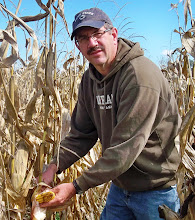Benjamin Crockett, Graduate Student, Crop and Soil Sciences
Hairy vetch is an important legume cover crop option for organic and conventional farmers in the Northeast. There is considerable interest in hairy vetch as a cover crop for benefits including nitrogen fixation, weed suppression, and erosion control. Adoption of hairy vetch by some producers has been limited due to negative farmer experience and the perception that it can be a problematic volunteer weed issue in winter cereals later in rotation. Weediness can occur with hairy vetch due to physical dormancy resulting from hard seed causing persistent seed banks.
My graduate work is focused on quantifying the soil persistence of hairy vetch in order to determine how long seed maintains viability in the field and the extent that it can become a weed. I am also evaluating organic and conventional management options for selective control of hairy vetch in winter wheat. Experiments were conducted at the Penn State Agronomy Farm and a USDA facility in Beltsville , MD.
A seed viability study was established to quantify seedling emergence and soil seed bank persistence of hairy vetch over time as influenced by soil burial depth, seed cultivar and mechanical seed scarification. Seed scarification entails knicking the seed coat of a hard seed in order for it to take up water and germinate. This seed burial study was initiated fall of 2009 when 500 seeds of three hairy vetch cultivars (Albert Lea, Groff, Nebraska) were placed at two burial depths (3 and 15 cm) with a mechanical scarification treatment (scarified vs. non-scarified). Samples were dug up every six months for 18 months to determine how much of the planted seed was still viable over time. Mechanically scarified treatments contained no viable seed after six months at both locations while non-scarified treatments had a maximum of 7.9% hard seed. Nearly all observed vetch emergence occurred within six months. Seed at the 15 cm depth decreased in total emergence by 24% and showed a small increase in seed bank persistence (max. 2.4%) compared to the 3 cm depth. Mechanical scarification of hairy vetch prior to planting has potential to be used as a preemptive weed management tactic to eliminate hard seed without lowering emergence.
In order to evaluate different tactics for selective control of hairy vetch weeds in a wheat crop, a study was established where hairy vetch was planted with winter wheat in the fall of 2009. Organic management tactics examined timing (fall vs. spring) and rate of application of three potential organic herbicides and propane flaming. Treatments included acetic acid (vinegar), ammonium nonanoate (Racer™), lemon grass oil (GreenMatch™) and propane flaming applied at two rates. Several conventional herbicides labeled in wheat applied in the fall and spring were also evaluated. In the conventional study, fall treatments were generally less effective than spring. Fall applied clopyralid and spring treatments of dicamba, dicamba + 2,4-D, tribenuron, mesosulfuron, pyroxsulam, and clopyralid provided the most consistent control. Most of the organic treatments did not effectively control hairy vetch. The high rate of flaming in the fall was the most effective and consistent tactic. Mechanical tine weeding in the fall was also examined and not found to effectively kill hairy vetch.




No comments:
Post a Comment